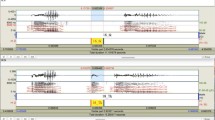Abstract
Most previous studies related to loanword adaptation have centered on segmental mappings between source and loanword sounds in morphologically simplex words (LaCharité and Paradis, Ling Inq 36:223–258, 2005; Kang, Phonology 20:1–56, 2003). However, few have considered the adaptation of complex words, specifically words made of multiple free morphemes. Examining the adaptation of complex English words into Korean, the present study makes four claims. First, it proposes that each component of a complex word is a unit for loanword adaptation in calculating sound mappings. Second, it suggests that each component word is a stem, whereas a loanword as a whole is categorized as a nominal word in Korean. Third, apparent single-unit adaptation is possible only when the first component allows variable final vowel epenthesis at the end of the first component word; this is analyzed in terms of split-base effects. Fourth, the allophonic realization of phonemes plays a crucial role in loanword adaptation. These claims are empirically supported by loanwords found via the National Academy of Korean Language (NAKL 1991) and Google searching (March–June 2011). Furthermore, this study provides an explicit formalization of the analysis of complex loanwords within Optimality Theory (Prince and Smolensky, Opimality Theory: Constraint interaction in generative grammar, 1993). The present study contributes to the literature of loanword phonology by shedding light on several issues. First, the study proposes a model for the adaptation of complex loanwords wherein both morphological structure and the phonetic information of the source language play important roles. There has been intense debate about the effect of input information on loanword adaptation, broadly split between a phonological view (LaCharité and Paradis, Ling Inq 36:223–258, 2005) and a perceptual view (Silverman, Phonology 9:289–328, 1992; Steriade, in: Hume and Johnson (eds.) The role of speech perception in phonology, 2001; Peperkamp and Dupoux, Proceedings of the 15th International Congress of Phonetic Sciences, 2003). The adaptation of complex English words in Korean supports the perceptual approach, in that the allophone realized in a complex word determines the loanword sound. It also reveals that sound mappings in loanwords are determined by the morphological structure of source words. There has been a discussion about whether the morphosyntactic base is isomorphic to the phonological base (Steriade, Lexical conservatism and the notion base of affixation, 2000). Component-by-component analysis of the apparent single-unit adaptation provides support for the existence of a split-base effect as well as for the lexical conservatism proposed by Steriade (Lexical conservatism and the notion base of affixation, 2000). Finally, it makes a contribution to evaluation of the internal structure and morphological category of complex loanwords, which has been rarely considered in the literature on loanword phonology.
Similar content being viewed by others
References
Beckman, Jill N. 1997. Positional Faithfulness. PhD dissertation, University of Massachusetts, Amherst.
Davis Stuart, Hyunsook Kang (2006) English loanwords and the word final [t] problem in Korean. Language Research 42: 253–274
Hay Jennifer (2001) Lexical frequency in morphology: Is everything relative. Linguistics 39(6): 1041–1070
Ito, Junko. 1990. Prosodic minimality in Japanese. In Parasession on the Syllable in Phonetics and Phonology, 213–239. Chicago: Chicago Linguistics Society, University of Chicago.
Kang Hyunsook (1996) English loanwords in Korean. Studies in Phonetics. Phonology and Morphology 2: 21–48
Kang Yoonjung (2003) Perceptual similarity in loanword adaptation: English postvocalic word-final stops in Korean. Phonology 20: 1–56
Kenstowicz, Michael. 1996. Base identity and uniform exponence: alternatives to cyclicity. In Current trends in phonology: Models and methods, ed. J. Durand, and B. Laks, 363–394. Salford: University of Salford.
Kenstowicz Michael, Atiwong Suchato (2006) Issues in loanword adaptation: A case study from Thai. Lingua 116: 921–949
Kim Soohee, Emily Curtis (2000) Phonetic duration of English /s/ and its borrowing in Korean. Japanese and Korean Linguistics 10: 406–419
Kwulipkwukeyenkwuwen [The National Academy of the Korean Language]. 1991. Oylaye sayong siltay cosa: 1990 nyendo [Survey of the state of loanword usage: 1990]. Seoul: NAKL.
Lacharité D., Paradis C. (2005) Category preservation and proximity versus phonetic approximation in loanword adaptation. Linguistic Inquiry 36: 223–258
Lee, Yongsung. 2001. The noun-verb asymmetry in Korean Phonology. Studies in Phonetics, Phonology and Morphology 375–398.
McCarthy, J., and A. Prince. 1995. Faithfulness and reduplicative identity. In Papers in optimality theory (University of Massachusetts Occasional Papers 18), ed. J. Beckman, L.W. Dickey, and S. Urbanczyck, 249–384. Amherst, Mass.: Graduate Linguistics Student Association.
Oh Mira (1992) Palatal consonants, labial consonants, and vowel epenthesis in Korean. Korean Journal of Linguistics. 17: 141–161
Oh Mira (1995) A prosodic analysis of non-derived environment blocking. Journal of East Asian Linguistics 4(4): 261–279
Oh Mira (1996) Linguistic input to loanword phonology. Studies in Phonetics, Phonology and Morphology 2: 117–126
Oh M., Kim H. (2006) A phonetic duration-based analysis for vowel epenthesis: English postvocalic word-final stops. Studies in Phonetics, Phonology and Morphology 12: 307–324
Peperkamp, S., and Dupoux, E. 2003. Reinterpreting loanword adaptations: the role of perception. Proceedings of the 15th International Congress of Phonetic Sciences, pp. 367–370.
Prince Alan, Paul Smolensky (1993) Opimality Theory: Constraint interaction in generative grammar. Ms, Rutgers University, University of Colorado
Silverman D. (1992) Multiple scansions in Loanword Phonology: Evidence from Cantonese. Phonology 9: 289–328
Smith, Jennifer L. 1997. Noun faithfulness: on the privileged behavior of nouns in phonology. Ms, ROA-242.
Sohn, Hyang-sook. 2001. Optimization of word-final coronals in Korean loanword adaptation. Ms, Kyungpook National University.
Steriade Donca (2000) Lexical conservatism and the notion base of affixation. Ms. University of California, Los Angeles
Steriade, Donca. 2001. Directional asymmetries in place assimilation: a perceptual account. In The Role of Speech Perception in Phonology, ed. E. Hume and K. Johnson, 219–250. New York: Academic Press.
Author information
Authors and Affiliations
Corresponding author
Rights and permissions
About this article
Cite this article
Oh, M. Adaptation of English complex words into Korean. J East Asian Linguist 21, 267–304 (2012). https://doi.org/10.1007/s10831-012-9089-4
Received:
Accepted:
Published:
Issue Date:
DOI: https://doi.org/10.1007/s10831-012-9089-4




